Transferts monétaires à usages multiples
Les transferts monétaires à usages multiples sont des transferts monétaires non affectés que les personnes vivant en situation de crise peuvent utiliser pour couvrir leurs besoins essentiels. Par nature, il s’agit de la modalité d’aide qui offre le plus de choix, de flexibilité et de dignité aux bénéficiaires. De plus en plus de données montrent qu’il est plus pertinent en termes d’optimisation des coûts et de rapport coût/résultat de répondre à plusieurs besoins à la fois.
Cependant, cette modalité exige aussi des acteurs humanitaires qu’ils mettent en place de nouvelles manières de collaborer, à toutes les étapes du cycle de programme, et entre secteurs. Même s’il existe des outils fiables pour faciliter la collaboration, ils ne sont pas mis en œuvre à grande échelle et le recours aux transferts monétaires à usages multiples est encore ponctuel. Il reste à relever plusieurs défis si nous souhaitons intégrer efficacement les transferts monétaires à usages multiples au système humanitaire.
Contenu associé
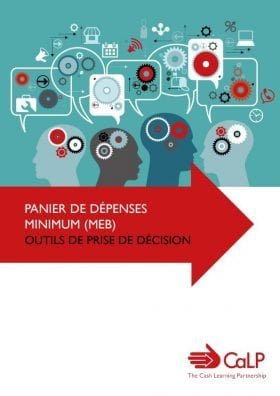
Panier de dépenses minimum (MEB) – Outil de prise de décision
Guides et outils
Cet outil de prise de décision est fait pour accompagner les praticiens et les décideurs à travers les étapes clés du processus de calcul du MEB. Elle décrit les différentes étapes et approches possibles du processus d’élaboration du MEB, et donne des liens vers de nombreuses ressources complémentaires.

Orientations opérationnelles et boîte à outils pour les transferts monétaires à usages multiples
Guides et outils
Les présentes orientations opérationnelles et la boîte à outils qui l’accompagne réunissent une expertise mondiale sur les interventions monétaires. Elles apportent aux acteurs humanitaires des orientations complètes et pratiques afin d’évaluer la faisabilité des transferts monétaires, d’en déterminer la conception et d’en structurer la mise en oeuvre. Les...

Définition des Paniers de Dépenses Minimum (MEB) en Afrique de L’Ouest
Rapport
Au cours de l’année 2017, 5 pays d’Afrique de l’Ouest ont lancé un travail collectif de définition du panier de dépenses minimum, afin de mieux comprendre la contribution de l’aide humanitaire à la couverture des besoins de base des populations affectées et d’améliorer son impact. Ce processus, souvent fastidieux, a soulevé des défis techniques, mais également mis en...
Thematic lead
Latest
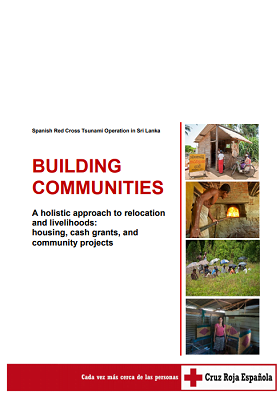
Building Communities: A holistic approach to relocation and livelihoods: housing, cash grants, and community projects
Case Study
This case study looks at the Spanish Red Cross’ housing reconstruction programme which took place between 2007-09 in Sri Lanka, following the devastating Tsunami. In addition to housing this intervention had two main approaches: household level grants for re-starting, supporting the strengthening or...
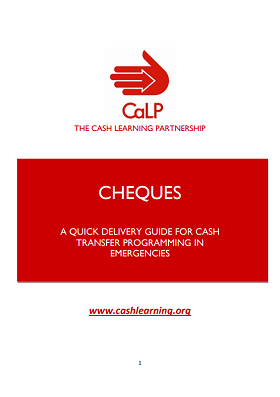
Cheques: A quick delivery guide for cash transfer programming in emergencies
Guidelines and Tools
A Quick Delivery Guide to delivering money through cheques. Prepared as a practical tool, this guide provides a brief synthesis of the necessary preconditions and advantages and disadvantages of using cheques. It also provides practical implementation tips.
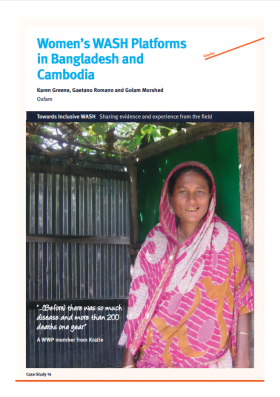
Women’s WASH Platforms in Bangladesh and Cambodia
Case Study
Oxfam’s multi-country portfolio is located in more than 100 remote rural communities in six countries and is funded by AusAID’s Civil Society Organisation WASH Fund. The water, sanitation and hygiene (WASH) projects in Bangladesh and Cambodia deliver multiple outcomes including improving water and...
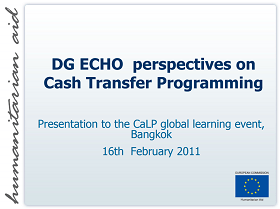
DG ECHO perspectives on Cash Transfer Programming
Presentation
A presentation accompanying the CALP Network global learning event, Bangkok 16th February 2011, covering the following topics: DG ECHO position on the use of Cash &Vouchers (C&V) Trends in funding C&V projects Using C&V at scale: the case of Haiti Capacity building priorities
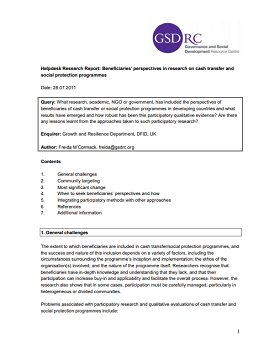
Helpdesk Research Report: Beneficiaries’ perspectives in research on cash transfer and social protection programmes
Report
Query: What research, academic, NGO or government, has included the perspectives of beneficiaries of cash transfer or social protection programmes in developing countries and what results have emerged and how robust has been this participatory qualitative evidence? Are there any lessons learnt from the...
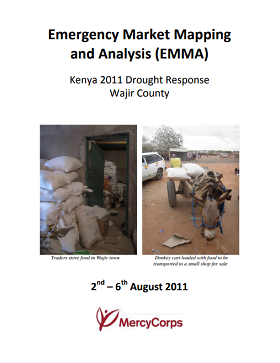
EMMA – Wajir, Kenya
Report
Mercy Corps conducted an adapted Emergency Market Mapping and Analysis (EMMA) assessment in Wajir County of Kenya from 2-6 August 2011. The assessment was organized as a response to the hunger crisis resulting from the worst drought in the region in the last 60 years. The EMMA methodology was adapted...

Delivering Cash Through Cards – A Quick Delivery Guide (booklet)
Guidelines and Tools
A Quick Delivery Guide to delivering money through cards (magnetic stripe or smart cards). Prepared as a practical tool, this guide provides a brief synthesis of the necessary preconditions and advantages and disadvantages of using cheques. It also provides practical implementation tips. This version...
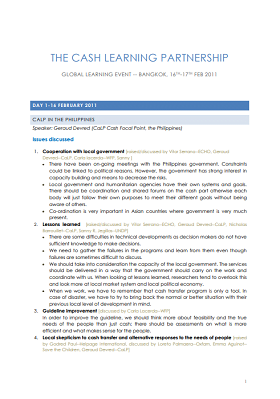
The CALP Network 4th global learning event: Global innovations and lessons learned from response in South and South-East Asia (Complete workshop notes)
Report
The 4th the CALP Network Global Learning Event was held in Bangkok, Thailand on the 16th and 17th February 2011, hosted by the CALP Network in partnership with the International Federation of the Red Cross and Red Crescent Societies (IFRC). This inter-agency event was designed to present the latest...
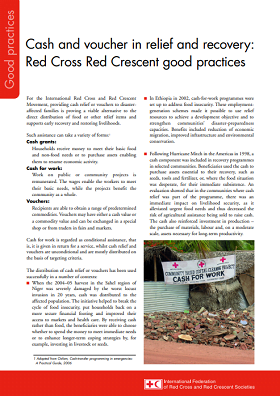
Cash and voucher in relief and recovery: Red Cross Red Crescent good practices
Report
A two-page brief giving some examples of the Red Cross / Red Crescent movement’s experience using cash grants, vouchers, and cash-for-work in emergency response.
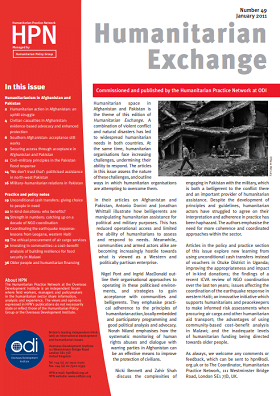
Humanitarian Exchange No. 49: Unconditional cash transfers: Giving choice to people in need
Report
This article in Humanitarian Exchange magazine (article begins on page 19) explains how Action Against Hunger has moved towards unconditional cash grants as a food security and livelihoods response in Northern Uganda. The article describes the technical features of the programme (transfer amount,...

Hard Cash in Hard Times: Cash transfers versus food aid in rural Zimbabwe
Case Study
This case study looks at Concern Worldwide’s pilot project to provide cash, instead of traditional food aid, to food insecure communities in Zimbabwe. The document briefly describes the conditions making it suitable for such a response, positive outcomes for the cash recipients, the cost effectiveness,...
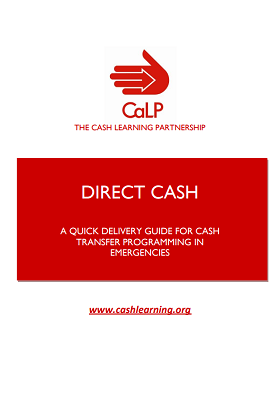
Direct cash – A quick delivery guide for cash transfer programming in emergencies
Guidelines and Tools
A Quick Delivery Guide to delivering money directly (‘direct cash’ or ‘cash in envelopes’). Prepared as a practical tool, this guide provides a brief synthesis of the necessary preconditions and advantages and disadvantages of using direct cash. It also provides practical implementation tips.
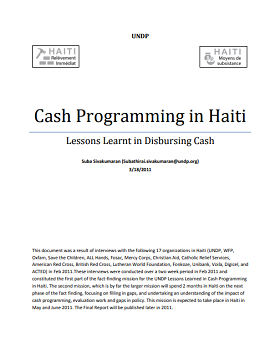
Cash Programming in Haiti – Lessons Learned in Disbursing Cash
Report
The following report is the result of an initial 2 week mission to Haiti to investigate cash programming (including cash for work) amongst 17 organizations. It is not intended as an exhaustive review of 17 organizations’ practices, but attempts to look at what were some of the critical stages in cash...
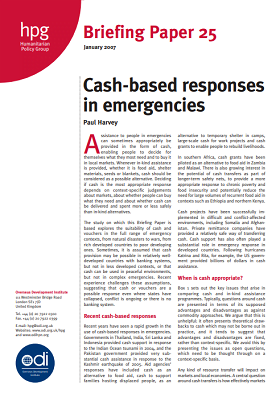
Cash-based Responses in Emergencies
Report
This short HPG briefing paper looks at the suitability of cash based responses in a range of emergency situations. It gives a rapid overview of recent cash based responses and examines the key issues around comparing cash and in-kind programmes. It briefly looks at the impact of cash, the issues of...
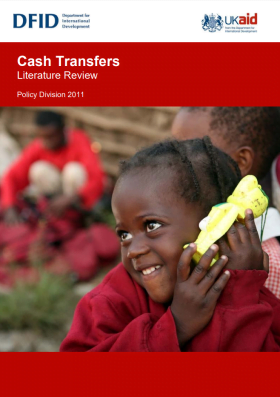
DFID Cash Transfers Literature Review
Report
This paper provides a synthesis of current global evidence on the impact of cash transfers in developing countries, and of what works in different contexts, or for different development objectives. Cash transfers are direct, regular and predictable non-contributory cash payments that help poor and...

Seeking Acceptance: The Promise of Cash in High-Risk Areas
Report
Somalia is one of the world’s most insecure states with a protracted conflict that continues to profoundly affect its civilians. Thirty-two percent of the Somali population – or 2.4 million of its 7.5 million people – is currently in need of humanitarian assistance (FSNAU, 2011a). The needs are...

Protection
Guidelines and Tools
Protection mainstreaming is a practical, efficient and effective means to maximise the protective impact of aid programming. Through incorporating protection principles into aid design and delivery, humanitarian actors can:
Promote the human rights of affected populations
Enhance affected populations’...
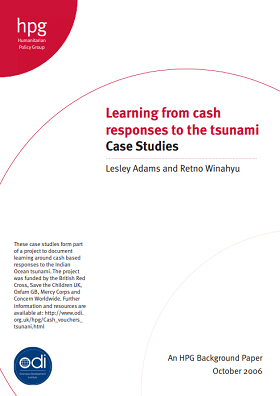
Learning from Cash Responses to the Tsunami: Case Studies
Case Study
These case studies form part of a project to document learning around cash based responses to the Indian Ocean tsunami. The project was funded by the British Red Cross, Save the Children UK, Oxfam GB, Mercy Corps and Concern Worldwide.
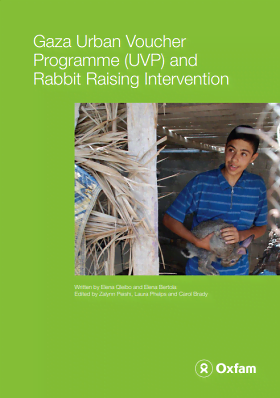
Gaza Urban Voucher Programme (UVP) and Rabbit Raising Intervention
Case Study
This case study looks at an Oxfam commodity voucher programme which supported households to improve their access to food, as well as a rabbit rearing intervention to help protect the livelihoods of unemployed people in the Gaza. The document looks at the rationale for programme choice, the project...

Vouchers – A quick delivery guide for cash transfer programming in emergencies
Guidelines and Tools
A quick delivery guide to using vouchers to implement a market-based emergency response. Prepared as a practical tool, this guide provides a brief synthesis of the necessary preconditions and advantages and disadvantages of using vouchers. It also provides practical implementation tips.

